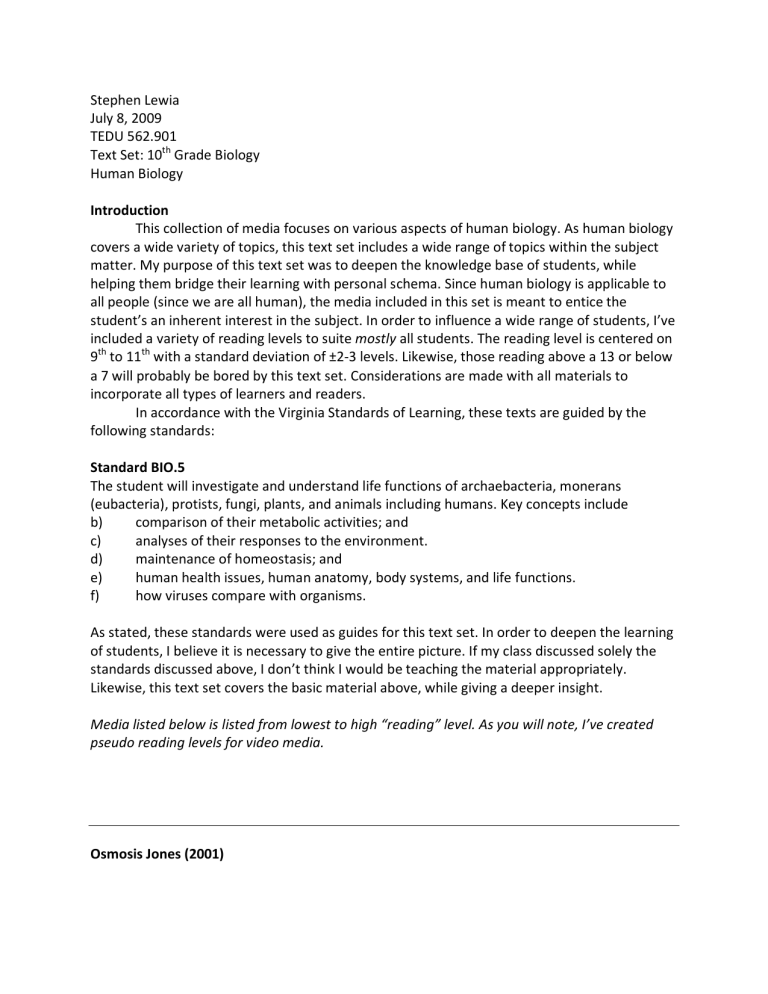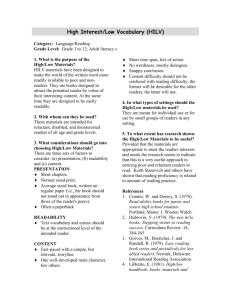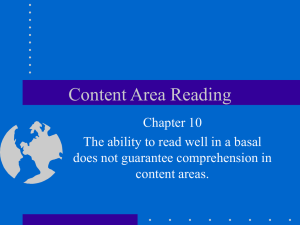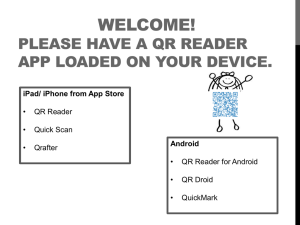10th Grade--Human Biology -- Stephen Lewia

Stephen Lewia
July 8, 2009
TEDU 562.901
Text Set: 10 th Grade Biology
Human Biology
Introduction
This collection of media focuses on various aspects of human biology. As human biology covers a wide variety of topics, this text set includes a wide range of topics within the subject matter. My purpose of this text set was to deepen the knowledge base of students, while helping them bridge their learning with personal schema. Since human biology is applicable to all people (since we are all human), the media included in this set is meant to entice the student’s an inherent interest in the subject. In order to influence a wide range of students, I’ve included a variety of reading levels to suite mostly all students. The reading level is centered on
9 th to 11 th with a standard deviation of ±2‐3 levels. Likewise, those reading above a 13 or below a 7 will probably be bored by this text set. Considerations are made with all materials to incorporate all types of learners and readers.
In accordance with the Virginia Standards of Learning, these texts are guided by the following standards:
Standard BIO.5
The student will investigate and understand life functions of archaebacteria, monerans
(eubacteria), protists, fungi, plants, and animals including humans. Key concepts include b) comparison of their metabolic activities; and c) analyses of their responses to the environment.
d) maintenance of homeostasis; and e) f) human health issues, human anatomy, body systems, and life functions.
how viruses compare with organisms.
As stated, these standards were used as guides for this text set. In order to deepen the learning
of students, I believe it is necessary to give the entire picture. If my class discussed solely the standards discussed above, I don’t think I would be teaching the material appropriately.
Likewise, this text set covers the basic material above, while giving a deeper insight.
Media listed below is listed from lowest to high “reading” level. As you will note, I’ve created pseudo reading levels for video media.
Osmosis Jones (2001)
Summary: Osmosis contains both animated and live‐action video to explain the adventures of
Osmosis Jones, a white blood cell. The story show Jones, and his friend Drix (an over‐the‐ counter drug pill), and their adventures to combat a virus. The movie shows both the “insides” of the body (via animation), and the actual person (via live action). The movie is comedic for all
ages, but surprising accurate.
This movie can connect with all learners with its comedic elements. At the same time, the amount of accurate information within the movie can be used to augment instruction. I can see students finishing the movie and not realizing the amount of information they’ve learned. I think it would be wise to include an organizational chart with this movie. Such a worksheet would organize the student’s learning into a visual representation that they can use later in the class. This movie could be used in both the preparation and the reflection phases of instruction.
I can see it being used to introduce the subjects to be covered while reviewing subjects learned.
I personally would use this as review media. I think after learning about the body, diseases, and
viruses, this movie will solidify learn in students.
I’ve given this video a pseudo “reading” level of 5‐7. This means I think it would be suitable for comprehension at these grade levels. That being said, I believe it can be invaluable in the high school classroom. The movie has elements that cannot be seen at a 5‐7 grade level. I compare this unseen deeper knowledge to the movie “Shrek.” Even though Shrek is based primarily for
kids, it is loved also by adults. The movie has elements for both age levels. The same holds true for Osmosis Jones.
Sick! Diseases and Disorders, Injuries and Infections (2000)
By David Newton, Donna Olendorf, Christine Jeryan, Karen Boyden (Editors)
Summary: This book is one of a series. It describes conditions listed in alphabetical order. The book focuses on the definition, description, words to know, causes, symptoms, diagnosis, treatment, prognosis, and prevention. They also list places to look for more information. The words used are simple to use, but still cover a considerable amount of depth. Since the SOLS require covering many of the topics discussed in this book, I believe it would be a perfect addition to this text set.
Readability:
Flesch Kincaid Grade Level: 7
Readability Analysis: I agree with the Flesche Kincaid analysis. This book is very easy to decode, has short sentences, and portrays concepts logically. Also, vocabulary is kept recognizable, with new words defined easily. The one thing I worry about with this book is the lack of pictures.
Reluctant Readers ‐ This may be hard to please for the reluctant readers. The text is an easy read, however there are little pictures. So, at first, a reluctant reader may not be interested in reading this book; however with some persuasion, I believe he/she may turn their opinion around.
Schema Activation ‐ I think if a student is genuinely interested in learning more about a topic within this book, they may activate schema. If the students actually have a disease covered in this book (or know of somebody who does) they definitely will “see themselves” in this book.
Augment/Replace?
– This book will probably be best used for augmentation and reference purposes only. With the wide variety of topics covered, I don’t think requiring students to read the whole book would be beneficial.
PAR ‐ This book would be great as a reference. Likewise, I would put this book in the reflection phase of instruction.
Instructional Support‐ This book can be read independently due to the level of readability.
The Human Mind Explained: An Owner’s Guide to the Mysteries of the Mind (1996)
By Susan A. Greenfield, General Editor
Summary: This very colorful book interestingly starts off by explaining how to read it! It describes its five “interlinked” sections: surveying the mind, building the brain, inputs and outputs, far horizons, and states of mind. Each one of these sections builds a better picture to how the mind words. The book uses amazing pictures, and colorful graphics. All pictures and graphics have explanations of what they mean. The book is laid out like an encyclopedia, but reads like a book.
Readability:
Flesch Kincaid Grade Level: 9
Readability Analysis: I agree with the Flesch Kincaid Grade Level. This book is a little more difficult to read than the previous book, but supplements with amazing graphics. Words are explained well through in text definitions and a glossary. Difficulty comes with long sentences and sparse use of technical words.
Reluctant Readers – I think this book’s color and pictures will attract reluctant readers. Also, once they get into reading the book, the will see how easy it reads with relation to the subject matter.
Schema Activation ‐ The mysteries of the mind can be very intriguing to young learners. I think this book has the potential to educate while entertain.
Augment/Replace?
– Since this book does not cover all of the content that needs to be covered
I would use it to augment instruction.
PAR ‐ This book can be used prior to, during, or after instruction. Its graphics work great to supplement instruction.
Instructional Support‐ This book can be independently, or within group. I also can see this book
being read aloud while utilizing an Elmo video projector.
The Stomach and Digestive System by the Reader’s Digest (2002)
By The Reader’s Digest
Summary: This book deals specifically with the digestive system, as outlined as necessary information for the biology SOLs. The book takes a textual and visual tour of the digestive
system, starting from the mouth, to the other end. The book is filled with colorful pictures and graphics, along labels. Once the tour is over, the book describes multiple abnormalities and disease processes that could occur in the digestive tract. Of course, photos and graphics and included!
Readability:
Flesch Kincaid Grade Level: 11
Readability Analysis: I disagree with the Flesch Kincaid grade level. I think this book should be around a 9 or 10. The readability is the same to the previous book. Again, great pictures make things easier to read and understand. All new topics are defined appropriately. Uses of technical words are sparse.
Reluctant Readers – I believe the colorful nature of the book will quickly intreuge the reader.
Also the very nature of the digestive system may be enough to influence some (while repulsing others). That being said, if the readability for reluctant readers is too high, this may cause frustration.
Schema Activation ‐ Since we all deal with our digestive system every day, this should activate schema; likewise building a bridge for learning.
Augment/Replace?
– This book can possibly be used as a replacement to the text (due the content and detail it provides. It may also be used as an augmentation to instructional material.
PAR ‐ I would use this book in the preparation phase of instruction. The photos show great examples of the material.
Instructional Support‐ This text can be read independently by strong readers, and in pairs with reluctant readers. Also, if used to replace the text, the teacher may elect to read aloud with the
Elmo .
National Geographic‐ Inside the Living Body (2002)
Summary: This movie takes a “National Geographic” tour of the human body. I would call this movie “Planet Earth” of the human body. It has received amazing reflection from both educators and movie goers. The amount of detail and factual information keeps things interesting while still being educational. The movie is basically a tour of the human. It utilizes graphics, pictures, and real‐life video. Part of the video are filmed from inside the body via a
“pill camera.” Due to the video is very graphic (i.e. shows things in great detail) this video would not be appropriate for students younger than high school age.
I gave this video a pseudo reading grade level of 10‐12. The purpose for this grade level is the amount of detail contained in the video. Also, the amount of detail is inappropriate for younger viewers. The teacher will still have to warn the class of specific parts that they may want to turn away, as they may make some viewers squeamish. This video does a great job of describing the information, so much so that I may use it as a supplement to other instruction. The section on
maintaining good health is phenomenal in the proper detail it provides.
A Field Guide to Germs
By Wayne Biddle
Summary: This book presents a novel at face value; however, when the reader opens it up, they find the book in fact is a reference material. It starts off by talking about disease in general. The introduction covers history of discovery, protection, and cure of disease. The book then details approximately 20‐30 different diseases. Each disease section talks about the discovery of the disease, what it looks like, and if there has been a human cure. The author is good about giving real‐life examples, as well as fun facts.
Readability:
Flesch Kincaid Grade Level: 12
Readability Analysis: I disagree with the Flesch Kincaid Grade Level for this book. This book readability is around 9 th grade, however other factors brought it up to 12. For example, the sentence tended to run on, and utilize large words. The problem is, however, the way the author uses long sentences has nothing to do with difficult readability. I believe the author was simply using long sentences! Also, the long words used in the book are common amongst high school students.
Reluctant Readers – Since this book looks like a novel (from the outside), this may scare off some reluctant readers. However, after beginning to read the novel, the reader will find the readability is quite easy. Again, it is important to note that reluctant readers may become frustrated when presented with this book due to its relatively high reading level. It would be the teacher’s responsibility to provide support for these readers through guides, previewing, etc.
Schema Activation ‐ I think many students can be frightened into the thought of horrible diseases. However this book brings this reality into a new light, and perhaps may change their perspective on this topic.
Augment/Replace?
– I would definitely use this book as an augmentation to regular instruction.
It contains much more information than necessary for a high school class.
PAR ‐ I would utilize this book during the reflection phase of instruction. This is due to the large amount of content it contains.
Instructional Support‐ This book would be used best for reference. Students will be able to
read it independently
Human Body: a visual guide
By Beverly McMillan
Summary: The book takes the reader on a great adventure through the body. It not only describes things through text, but through amazingly colorful pictures and drawings. The reader could probably learn three quarters of the material by simply looking at the book. The book starts out with the journey through the body, bridges to disease processes, and ends with a
“Factfile” of information on our species. This epilogue includes interesting information on
disease processes, medical timelines, and human development markers. This covers multiple requirements of the VA SOL in vivid detail.
Readability:
Flesch Kincaid Grade Level: 13
Readability Analysis: I agree with the Flesch Kincaid Grade level. This book’s use of difficult topics may make reading difficult. The book is supplemented by photos, captions, definitions, and a glossary that do help the reader understand the material.
Reluctant Readers – the pictures intrigue mostly anybody; mostly because they are bright and colorful. The text may be slightly challenging to some high school readers; however I think a little extra time allotment will suffice. Additional instructional aides, such as a KWL, may also help guide the reader.
Schema Activation ‐ I think we’re all intrigued about our body, and that is how I can set up this lesson.
Augment/Replace?
– This text may replace certain shortfalls in the official text, but mainly should be used for augmentation.
PAR ‐ I would probably use this book for reflection purposes only.
Instructional Support‐ This book would be best used in groups, or individually (for strong readers)
The Human Body (1988)
By the editors of Time‐Life Books
Summary: The book talks about “new” (based on the publication date of 1988) incorporations of science and technology with the human body. Examples include PET and MRI scanning, and their benefits to developing new technologies to prevent/recognize/combat disease processes.
This relates to the topic as it instructs readers on bodily function while integrate technology with future developments.
Readability:
Flesch Kincaid Grade Level: 13
Readability Analysis: I agree with the Flesch Kincaid Grade level. Not only is the text written at a high grade level, the old book is old and outdated. Looking through the book I believe current high school students may become distracted by the outdated pictures and technology used.
Likewise I would not recommend this book for any reference purpose.
Reluctant Readers – lots of interesting pictures! However reading level is high. Maybe be engaged by thoughts of new technology.
Schema Activation ‐ I think students will not activate schema with this book. It is old and outdated and hard to relate.
Augment/Replace?
– I personally wouldn’t use this book at all! If I HAD to, I would augment my instruction to utilize accurate portions.
PAR ‐ Again, if I HAD to use this book, I would use it for reference purpose only.
Instructional Support‐ This book needs to be read with an adult (especially with somebody who knows about current technology). I fear if students read this book independently, they may be taught out‐of‐date, incorrect information. That being said, I still think this text provides a valuable comparison for students. The teacher can emphasize the differences in modern and
out‐dated knowledge. In fact, a project could be created where the students would be responsible for finding differences in modern and out‐dated information.
I think it is important to note the difficulty in find sources on this topic that cater specifically to high school student. I say this, not in reference to this assignment, but in regards to the implications to the young of today. During my search for material I found material focused around big health issues for adolescents (drugs, sex, booze, etc.). These books were practically all I found on the topic of general health, anatomy, and physiology. I would guess the main source of information that adolescents find “valid” is internet resources. The potential problem with this is the validity of the internet. Books technically go through months to years of review prior to publication. It’s usually safe to say that material in a book is correct. On the internet, however, the validity is usually unknown. I wonder how the effects of internet will take an effect of the perceptions of correct health information in the future. If a curious young adult goes to the library to find out more about how the body works, it will be difficult for them to find literature on the subject (especially since I check out all the books). This should be considered by educators on this subject. We have a responsibility to show our students were they can find the correct information. My study found that student searches may no long occur in a book.
Bibliography
Biddle, W. (1995).
A Field Guide to Germs.
New York: Harry Hold and Company Inc.
Farrelly, B., & Farrelly, P. (Directors). (2001).
Osmosis Jones [Motion Picture].
Goodman, K., & Simon, K. (Directors). (2002).
National Geographic ‐ Inside the Living Body
[Motion Picture].
Greenfield, S. A. (Ed.) (1996).
The Human Mind Explained: An Owner's Guide to the Mysteries of the Mind.
New York: Henry Holt and Company.
McMillan, B. (2006).
Human Body: a visual guide.
New York: Fiefly Books Inc.
Newton, D., Olendorf, D., Jeryan, C., & Boyden, K. (Eds.) (2000).
Sick! Diseases and Disorders,
Injuries and Infections.
New York: Gale Group.
The Reader's Digest. (2002).
The Stomach and Digestive System.
Pleasantville: The Reader's
Digest Association Inc.
Time‐Life Books. (1988).
The Human Body.
Richmond: Time‐Life Books Inc.







